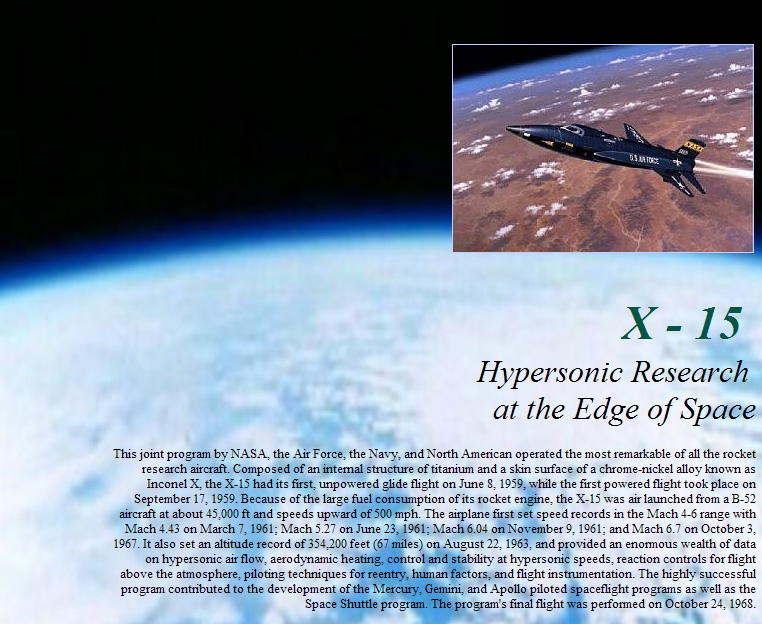

To the Edge of Space.....


The North American X-15, a rocket-powered research aircraft, bridged the gap between manned flight in the atmosphere and space flight. After its initial test flights in 1959, the X-15 became the first winged aircraft to attain hypersonic velocities of Mach 4, 5, and 6 (four to six times the speed of sound) and to operate at altitudes well above 30,500 meters (100,000 feet).
The X-15 was carried to an altitude of 12,000 meters (40,000 feet) under the wing of a Boeing B-52 bomber. During one test, it attained an altitude of over 108 kilometers (67 miles), flying so high that it functioned more as a spacecraft than an airplane. In 1967 it reached Mach 6.72 (7,297 kilometers or 4,534 miles per hour).
The X-15 was designed to explore the problems of flight at very high speeds and altitudes. The X-15 and other research aircraft contributed to the advancement of aerospace technology.
The X-15 program was a joint effort of NASA, the USAF, and the U.S. Navy. NASA had technical control of the program and did the conceptual design of the aircraft. The USAF and the Navy funded the design and construction and managed those phases of the program. Three aircraft were constructed, and two B-52s were modified to carry the X-15 under the right wing, between the fuselage and the inboard engine.
The three X-15 aircraft were flown by twelve test pilots. There were 199 flights beginning June 8, 1959 and ending October 24, 1968. The initial eight flights were made by Scott Crossfield. Neil Armstrong flew seven times.
The X-15's long cylindrical fuselage had lateral fairings to house control systems and fuel tanks. The thick wedge-shaped tail fins of the X-15 provided directional stability at speeds where conventionally shaped airfoils were not effective. The lower section of the ventral fin was jettisoned before landing to give clearance for the retractable skids which formed the main landing gear. The large tail surfaces and the downward slant of the wings enabled the aircraft to remain stable during steep climbs and at high altitudes.
The substructure of the X-15 was titanium with a covering of Inconel X, a nickel alloy capable of withstanding temperatures of 650°C (1,200°F). The black color of the aircraft helped to dissipate heat, and the gaps along the fuselage closed as the external temperature increased. The small holes near the nose were attitude control jets, used at very high altitudes where airfoil surfaces no longer provided aerodynamic control.
Although initial flights were made with an interim LR-11 engine, most flights were powered by a Reaction Motors (Thiokol) XLR-99 rocket engine with a thrust rating of about 70,000 lbs (31751 kg) at altitude.
An advanced command augmentation type control system, the MH-96, was developed by Minneapolis-Honeywell and added to the aircraft during the course of the program.
| X-15 | X-15A-2 | |
| Length | 50' 3" | 52' 5" |
| Height | 11' 7" | 14' |
| Wingspan | 22' 4" | 22' 5" |
| Empty Weight | 11374 lbs | |
| Gross Weight | 31275 lbs | 56132 lbs |
| Range | 275 miles | 250 miles |
| Max Speed | 4104 Mph | 4520 Mph |
| Ceiling | 314750 feet | 354200 feet |